
Images of Liberty and power: Art and Politics
[Created: 19 April, 2015]
[Updated: January 31, 2023 ] |
[I am currently reorganising this collection.]
This is part of a collection of works of art and other images I have used in my teaching or have commented upon over the years. They are roughly divided into two groups, those that deal with "Art and Politics" (this page) and those with the "Art of War and Peace" (on another page)
Here is a listing of what is available from three different websites: from the OLL sebsite : my old blog : this current website
A Selection From the OLL:
I have another collection at the OLL website, the most important of which are:
- “New” Socialist Ideas in the 1848 Revolution
- Abraham Lincoln as the “Federal Phoenix” (1864)
- Adam Smith and J.B. Say on the Division of Labour
- Algernon Sidney (1622-1683) and the Thomas Hollis Library of Liberty
- Art of the Levellers
- Brueghel, Taxes, and the Numeration of the People of Bethlehem (1566)
- Cobden and the Anti-Corn Law League
- Declaration of the Rights of Man and of the Citizen
- Eugène Delacroix on Press Censorship during the Restoration (1814-1822)
- Images of the British Abolitionist Movement
- Jacques Callot, Hugo Grotius, and the Miseries of War in the 17th Century
- James Gillray on War and Taxes during the War against Napoleon
- Liberty slaying the Monsters of Tyranny and Oppression
- Lilburne quoting Coke on English Liberties at his treason trial (1649)
- Ludwig von Mises on Rationing in WW2
- Mises on Gresham’s Law and Ancient Greek Silver Coins
- Monuments to Free Trade: Bastiat and Cobden
- New Playing Cards for the French Republic (1793-94)
- Ngrams and the Changing Vocabulary of Class Analysis in 19th Century Classical Liberal Thought
- Presidents Day and the Apotheosis of Washington
- Samuel warns the Israelites of the Dangers of Kings
- The Divine Right of Kings or Regal Tyranny? (Hobbes and Lilburne)
- The People and the Ruling Elite in Caricatures (Wade and Daumier)
- The Spanish-American War and the Anti-Imperialism League (1902)
- The Très Riches Heures du Duc de Berry (1416)
- Thomas Clarkson and the Abolition of the Slave Trade
- Thomas Hollis and John Locke
- Thomas Jefferson in the Cyclopedia
- Tocqueville and Bastiat on the 1848 Revolution in Paris
- Washington and Napoleon in their Study
- William Blake’s Illustrations of the Book of Job
From my old blog:
Some "Illustrated Essays" at this website (the first link is to the brief description below, the second to [more] - to the essay proper):
- Images of the Anti-Tax Smuggler Louis Mandrin (1725-1755) - the 18thC French Robin Hood [Jan. 2017) - [longer essay]
- Look magazine's illustrated version of Hayek's The Road to Serfdom (1945) (Jan. 2017) - [the complete collection of 18 images]
- Illustrations for a "sampling" of Bastiat's The Law (1850) (Jan. 2017) [more]
- "Eugène Delacroix on Press Censorship and Liberty during the Restoration (1815-1830)" ((Sept. 16, 2001) [More]
- "An Anti-Socialist Cartoon from 1848 : Amédée de Noé, dit Cham, "Ce qu'on appelle des idées nouvelles en 1848" (What are called "New Ideas" in 1848)" (15 July, 2014) - [More]
- “The Burdens on the Modern Atlas (early 21stC) ” (September 29, 2011) - [more]
- "Béranger's Song of "The Smugglers"" (October 27, 2011) - part of a longer essay on "Béranger's "Songs of Liberty”” [More]
- "Spying by the State: Jeremy Bentham's plan for a "Panopticon" (all-seeing) penitentiary, and Covers for Penguin editions of George Orwell's dystopian novel Nine-Teen Eighty Four (1949)" (12 July, 2014) - (there is no longer essay)
- "Women & Children on Voting Day: An anti-"Votes for Women" Poster (c.1909)" (Nov. 8, 2010) - [more]
- "Republican & Imperial Leaders (Washington & Napoleon) in their Studies" (Nov. 19, 2010) - [more]
- "The Divine Right of Kings or Regal Tyranny?: Frontispiece to Thomas Hobbes, The Leviathan (1651)" (Dec. 1, 2010) - [more]
- "Liberty Slaying the Monster of Tyranny and Oppression: Pierre Paul Prud'hon et Jacques Louis Copia, "Liberty overthrowing the Hydra of Tyranny (1793)" (Dec. 3, 2010) - [more]
- "Monuments to Two 19th Century Free Traders: Frédéric Bastiat (1801-1850) & Richard Cobden (1804-1865): Gabriel-Vital Dubray, "Frédéric Bastiat" (1878)" (Dec. 4, 2010) - [more]
- "Images used by the British Abolitionist Movement in the 1780s: "Am I not a Man and a Brother?" Official Medallion and Motto of the British Society for Effecting the Abolition of the Slave Trade (1787)" (Jan. 2, 2011) - [more]
- "Thomas Hollis' Imagery of Liberty. "Thomas Hollis, Fellow of the Royal Society, Member of the Society of Antiquaries 1767," by Giovanni Battista Cipriani [c.1767]" (Feb. 4, 2011) - [more]
- "New Playing Cards for the French Republic (1793-94): The Spirit of Commerce (Motto: "Wealth")" (Feb. 9, 2011) - [more]
- "Presidents Day and the Apotheosis of Washington: John James Barralet, "The Apotheosis of Washington" (1802)" (Feb. 21, 2011) - [more]
- "Tax Return Filing Day and the Tax Eaters: Honoré Daumier, “Gargantua” (1831)" (April 10, 2011) - [more]
- "An anti-Gaddafi Mural in Benghazi" (June 27, 2011)
- "Thomas Nast and the Slavery of the Income Tax (1878)" (Nov. 13, 2010) - [More]
The 18th Century French Robiin Hood - Louis Mandrin (1725-1755)
 |
Louis Mandrin (1725-55) was a famous 18th century French brigand and highwayman who challenged the privileges of the Farm General (la Ferme générale - or "Tax Farmers") by smuggling goods which were the monopoly of the Farm General across the French border . The Farm General was reorganized in 1726 to include a group of 40 (later 90) politically well connected individuals (the Farmers General - "les Fermiers généraux) who were given exclusive contracts by the king (via the Minister of Finance who received his cut in the form of bribes, or "pots-de-vin") to sell and thereby collect taxes on such items as salt, tobacco products, wine, and to enforce compulsory work on public goods such as roads (the octrois). This was an early version of "contracting out" or "privatizing" the collection of customs and taxes and was much hated by ordinary people in the 18th century. When the Farmers General were abolished in 1971 28 of the members were arrested and executed, including the mathematician Antoine Lavoisier. Mandrin was under contract with the Farm General to supply mules to the French army but when most of the died in transit the Farm General refused to pay him. After several run ins with the law resulting in Mandrin being condemned to death in 1753 and after his younger brother was executed for counterfeiting, Mandrin "declared war" on the Farmers General and began smuggling untaxed goods across the Swiss border and selling them in France. He became a popular hero for resisting the tax collecting Farmers General, which he did for the following 2 years before he was finally arrested and executed. Mandrin became a folk hero about whom popular songs were written and in the 20th century even films and a TV show were made about his exploits. A local Grenoble dark beer was also named after him in 2002. [See the longer essay.] |
Look magazine's illustrated version of Hayek's The Road to Serfdom (1945)
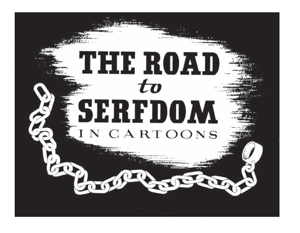 |
As a companion piece to FEE's condensed and illustrated version of Bastiat's The Law (1850, late 1940s) here is a condensed and illustrated version of Friedrich Hayek's The Road to Serfdom (1944). This is what Wikipedia has to say about this version: "A condensed version of the book written by Max Eastman was then published as the lead article in the April 1945 issue of Reader's Digest, with a press run of several million copies. This condensed version was then offered as a Book of the Month selection with a press run of over 600,000 copies. In February 1945 a picture-book version was published in Look magazine, later made into a pamphlet and distributed by General Motors." [Since General Motors has been the recipient of a massive government bailout by the Obama administration I'm not sure they would support Hayek's or Bastiat's views about the free market today and would probably disavow their affiliation with this edition today.] See the complete collection of 18 images. |
Illustrations for a "sampling" of Bastiat's The Law (1850)
 |
One of Frédéric Bastiat's most powerful essays is La Loi [The Law] which was published as a stand alone booklet in 1850. It was written, as was l'État [The State] (1848), as part of his reaction to the rise of socialism during the 1848 Revolution in France. Bastiat's writings were popular for a period in Europe, being quickly translated into many European languages and they and the French editions of his works remained in print throughout the 19th century. English translations were also quickly made and Bastiat even had a "school" of followers in the late 19th century in America. Unfortunately his ideas were forgotten until the Foundation for Economic Freedom began to rehabilitate his work with new English translations in the late 1940s. The biography they had written and the new translations of the Economic Sophisms and Economic Harmonies which appeared in the mid-1960s were crucial to the revival of interest in North America in the post-war period. FEE has recently posted on their website this charming abbreviated and illustrated version of The Law [Bastiat for Dummies?] which they published in the late 1940s. |
Eugène Delacroix on Press Censorship and Liberty during the Restoration (1815-1830)
Detail from Anon. "Les Journaux en mai
1815"
Detail from Anon. "Les Journaux", Le
Nain jaune (1814) |
These two details from anti-censorship caricatures from 1814-15 show how the opposition liberal press reacted to the crackdown on press freedom by the restored French monarchy. On the left we see a figure representing the liberal journal Le Censeur edited by Charles Comte and Charles Dunoyer. They have broken free of the muzzle and reins of the government censors and continue to hurl lightning bolts and shine the light of criticism on the regime. On the right we see an archer dressed in yellow depicting the liberal satirical journal Le Nain jaune (the yellow dwarf) who fires his critical arrows at representatives of the old order - the chruch, the aristocracy, and the monarchy. The nun representing the pro-church press holds a death's head doll and her speech bubble says "guerres aux idées libérales" (war against liberal ideas). [For more discussion of these political cartoons see this page.] |
An Anti-Socialist Cartoon from 1848 : Amédée de Noé, dit Cham, "Ce qu'on appelle des idées nouvelles en 1848" (What are called "New Ideas" in 1848)
 |
Sometime during 1848 the 30 year old French caricaturist Amédée de Noé (1818-1879) (nicknamed "Cham") drew this panel of six anti-socialist cartoons in which he ridiculed the claims of leading advocates of socialism that their ideas were new and that they were the key to solving France's economic and political problems. He directs his barbs against the following individuals:
[See the longer essay] |
“The Burdens on the Modern Atlas (early 21stC) ” (September 29, 2011)
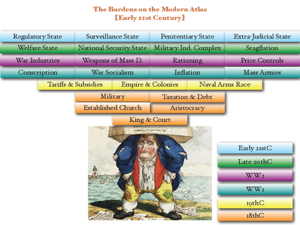 |
I was messing about with a revision to a lecture on war and the growth of the modern state when I remembered this caricature about John Bull bearing the burdens of Atlas in this marvellous print from 1816 [see details]. I wondered how his burdens might have changed over the course of two centuries and how the artist might have returned to the image in 2016. Here is my interpretation. The layers of his burden are colour-coded by century. [See a JPG image 1024 px]. |
“Béranger's Song of "The Smugglers”” (October 27, 2011)
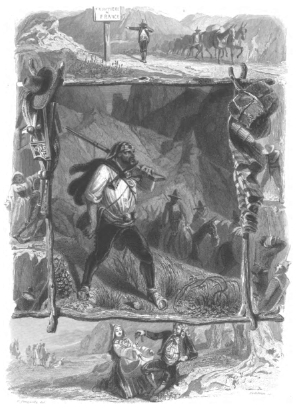 |
Pierre-Jean de Béranger (1780-1857) was a French poet and songwriter who rose to prominence during the Restoration period with his funny and clever criticisms of the monarchy and the church, which got him into trouble with the censors who imprisoned him for brief periods in the 1820s. In a poem called "The Smugglers" he sings the praises of the courageous men who defy state restrictions on the free movement of people and goods across arbitrary state borders. The date is not stated but it could be from the time of Napoleon's "Continental Blockade" (1806-14) when he attempted a form of economic warfare against Britain by keeping British goods out of European markets. The free trade and libertarian sentiments of the poem are quite clear. In the refrain he says "Hang the excisemen!"(which is a bit harsh - the French says "down with" but the contemporary English translator thought a stronger word was called for) and that "We (the smugglers) have the people on our side". He justifies smuggling on a number of grounds. One powerful reason is that modern state legislation interfering with trade breaks long-standing taditional ties of language and local law. Another reason is that there are strong economic reasons for engaging in trade, namely that it is "convenient" for both parties and that it disseminates wealth to a large number of people ("To bring down plenty to the reach of all, And wealth diffuse"). Government taxes block this necessary exchange and whether governments like it or not, a "balance" in trade must be struck one way or another. He also has a strong objection to what the taxes raised by tariffs will be spent on by the government. There are the excesses of the aristocratic life, the "fish-ponds" they build for amusement and not for productive purposes; then there is the expenditure on war which at this time was 90% or more of all government expenditure. Thus, by not paying taxes the smugglers create wealth for the ordinary people and limit the state's ability to pay for wars. The images above come from a 1847 edition of Béranger's Complete Works] One verse goes thus:
[longer essay on "Béranger's "Songs of Liberty".] |
"Spying by the State: Jeremy Bentham's plan for a "Panopticon" (all-seeing) penitentiary, and Covers for Penguin editions of George Orwell's dystopian novel Nine-Teen Eighty Four (1949)" (12 July, 2014)
Jeremy Bentham's plan for a "Panopticon"
(all-seeing) penitentiary |
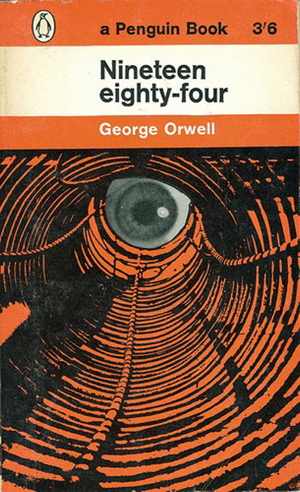 |
 |
Covers for Penguin editions of
George Orwell's dystopian novel Nine-Teen Eighty Four
(1949) |
|
Women & Children on Voting Day: An anti-"Votes for Women" Poster (c.1909) (November 8, 2010)
 |
The other image is a poster entitled "Election Day" and its purpose is to show the dangers of allowing women to vote. The poster is date stamped 1909 which gives some indication of its historical context. Women in America did not get the vote until 1920 even though some southern hemisphere countries like New Zealand and South Australia got it much earlier (1893 and 1894 respectively). The woman is clearly a "suffragette" who believes women should have the right to vote (see the sign "Votes for Women" on the wall at the top right) and is going off on election day to agitate for the cause. The poster depicts men's opposition to this idea, playing on the fear that if women get the vote they will become so involved in politics that they will neglect their domestic role and leave the care of the children with their clueless husbands (but note that the washing up has been done, if not put away). In the bottom right corner there is a hard to read letter with the disparaging title "Hen Party" and the names of women such as "Mrs. Henry Peck".... [more] |
Republican & Imperial Leaders (Washington & Napoleon) in their Studies (November 19, 2010)
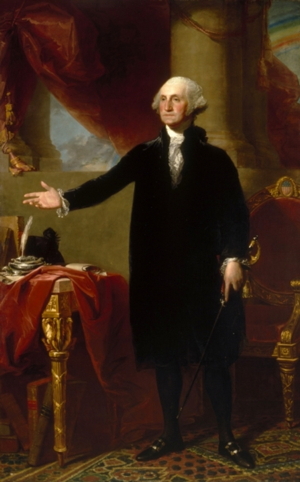 |
The painting on the left [Gilbert Stuart, George Washington (1796) (“the Lansdowne Portrait”)] shows Washington as a “working President” who has been writing a report or proposal of some kind requiring considerable research. The most important thing Washington wrote in 1796, on which he might have been working in the painting, is his “Farewell Address” which was published in September. It has been suggested that the 2 books on the table might be a copy of The Federalist and the Journal of Congress although this is hard to tell from the image. His simple attire is in keeping with enlightened notions of simplicity, frugality, and an avoidance of old regime regal luxury. There are 2 references to Roman traditions with the table leg fasces (a symbol of republican strength where multiple wooden rods are tied into an unbreakable bunch) and the Roman-style columns. Roman models were chosen for American political bodies such as the Senate, the Capitol building, and for the architectural design of many other public buildings. The rainbow in the background is an allegory that suggests that the political and military storm which had wracked the new republic during its war with great Britain was now over and that a “new era” of freedom was dawning.... [more] |
"The Divine Right of Kings or Regal Tyranny?: Frontispiece to Thomas Hobbes, The Leviathan (1651)"
 |
On the left is the famous frontispiece to Thomas Hobbes, The Leviathan (1651). The book's motto was the Latin "Non est potestas Super Terram quae Comparetur ei" (There is no power on earth to be compared to him). The Leviathan (or the absolute monarch) is wearing a crown and holding a sword (a symbol of military power) and a crosier (of religious power). His body is literally the “body politic” as it is made up of millions of his subjects. He is thus also literally the “head” of state. He stands above the two pillars of his power: the army (the column on the left) and the established church (on the right). From top to bottom, the left shows symbols of the Army (a castle, a crown, cannon, weaponry, and battle); the right shows the corresponding symbols of the Church (a cathedral, a bishop’s mitre, excommunication, logic, and a religious court). There couldn't be a better depiction of the notion of "throne and altar" which formed the basus of state power in the 17th century.... [more] |
Liberty Slaying the Monster of Tyranny and Oppression: Pierre Paul Prud'hon et Jacques Louis Copia, "Liberty overthrowing the Hydra of Tyranny" (1793)
 |
This is a French engraving from 1793 by the illustrator Pierre Paul Prud'hon (1758-1799) and the engraver Jacques Louis Copia (1764-1799). It shows a rather bedraggled looking Liberty (quite Amazonian in my view and very different from the better dressed Minerva) wearing a rough dress which exposes one breast, and an animal skin tied around her shoulder. She wears a laurel crown on her head. In her right hand she is holding an axe with a very broad blade; in her left she is holding a yoke used to harness a horse or ox to a plough or wagon. Under her right foot is the head of a slain king (despot) with his crown now dislodged; behind her lies a multi-headed hydra (we can see at least three heads) which she has also killed. The hydra was a mythical Greek creature which had nine heads and the body of a serpent. A pool of blood lies between two of the heads. The motto says "She has overthrown the hydra of Tyranny and smashed the yoke of Despotism.". [more] |
Monuments to Two 19th Century Free Traders: Frédéric Bastiat (1801-1850) & Richard Cobden (1804-1865)
 |
A monument erected in memory of the French free trade advocate Frédéric Bastiat (1801-1850) in the town of Mugron in S.W. France (1878). The sculptor was Gabriel-Vital Dubray (1813-1892). The original monument was largely destroyed by the Nazis in 1942. A contemporary engraving shows what it looked like ... Many statues and monuments are erected in public places to military leaders, kings, emperors, and presidents who take their countries to war, raise taxes, increase economic regulation of the economy, and violate civil liberties. Far fewer are the monuments to people who actually increase the sphere of liberty in which individuals can run their lives and businesses. We have two examples of the latter here: two men who agitated for and eventually helped create the conditions for expanded free trade among the people of Europe in the mid-19th century - Richard Cobden (1804-1865) and Frédéric Bastiat (1801-1850). [more] |
Images used by the British Abolitionist Movement in the 1780s: "Am I not a Man and a Brother?" (1787)
 |
The British Society for Effecting the Abolition of the Slave Trade was founded in 1787 by a group (predominantly Quaker) of committed anti-slavery advocates who attempted to change public opinion about the morality of slavery and to persuade Parliament to enact its abolition throughout the empire. Early members inlcuded William Wilberforce (a member of parliament), Thomas Clarkson (a gifted orator and writer), and Josiah Wedgwood (a successful pottery industrialist). A key to their success was a clever marketing campaign to arouse public opinion in favour of abolition. Using designs created by Wedgwood, the committee disseminated medallions, cameo jewelry, seals, coins, and pamphlets showing the classic image of the kneeling African slave, with chains on his hands and legs, asking the very pertinent question which cut to the heart of the immorality of slavery: "Am I not a man and a brother?". [more] |
Thomas Hollis' Imagery of Liberty (Feb. 4, 2011)
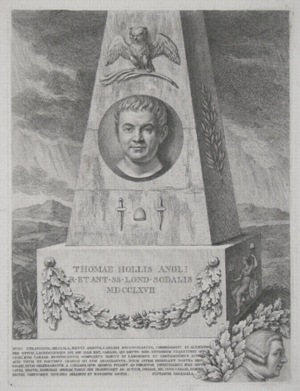 |
Thomas Hollis (1720-1774) came from a wealthy English family who spent much of his time promoting the cause of liberty in England, Europe, and the American colonies. He was most influenced by the theorists and politicians of the English Revolution in the mid- and late-17th century, such as John Milton, John Locke, Algernon Sidney, Andrew Marvell, and Edmund Ludlow. He reprinted their works in the 1750s and 1760s and distributed them to libraries across Europe and the Americas, especially the library of Harvard University with which his family had had a long relationship. Hollis' edition of John Locke's Two Treasises of Government (1764) was widely distributed and read in the American colonies and is regarded as an important mechanism for the transmission of Lockean ideas before the American Revolution. The special twist Hollis gave to his book publishing venture was to make beautifully bound volumes which included expensive and subtle design work (such as embossed emblems of Phrygian or "liberty" caps and daggers representing Brutus's assassination of the tyrant Julius Caesar). He also had elaborate frontispieces made to his specific design. Some of these were turned into "postcards" which he distributed separately in order to promote these ideas of republican and individual liberty. [more] Left: "Thomas Hollis, Fellow of the Royal Society, Member of the Society of Antiquaries 1767," by Giovanni Battista Cipriani [c.1767] |
New Playing Cards for the French Republic (1793-94): The Spirit of Commerce (Motto: "Wealth")
 |
This image comes from a pamphlet announcing a new design for playing cards that were more suitable for the conditions of post-revolutionary France than the traditional "feudal" or aristocratic designs. One motivating factor was the blatant contradiction they could see between playing cards which showed representatives of the old order (kings and queens and knights) which had so recently been overthrown in a bloody revolution. To right thinking republicans and to others "of taste" the constant reminder of the leaders of the old order, caused by looking at the face cards of a deck of cards was offensive. So Citizens Jaume and Dugourc set about creating new playing cards which could serve not just as a means to while away the hours in pleasant games but which would also be a "Manual of the Revolution", reminding players of "the spirit of all the characters of Liberty and Equality". [more] |
Presidents Day and the Apotheosis of Washington
 |
In the United States the third Monday of February is designated "Washington's Birthday", better known by the name "Presidents Day". There appear to be two main periods for the creation of images of the apotheoisis of Washington. The first comes immediately after his death in 1799 and the second comes after the assassination of Abraham Lincoln (April 1865). The image above was drawn by John James Barralet and it appeared in various forms between 1802 and 1816. It shows George Washington ascending into heaven assisted by Father Time and an angel (or "Immortality"). Shafts of light shine down from heaven through a break in the clouds as the angel and Father Time lift Washington, wrapped in a red burial shroud, from tomb. To the left are three women (Faith, Hope, and Charity). Beneath Washington can be seen an American eagle, the American shield on which is written "e pluribus unum" and Liberty, whose head is bowed in sorrow. Her staff with the red phrygian cap is resting among Washington's discarded armour and sword which lie beside a facses. In the far right bottom corner we can see a American Indian with his hatchet and arrows sitting with his head resting on his knees. This is one of many images of Washington which appeared in the 19th century. He appeared on stamps, paper money, postcards and prints, as well as a monumental fresco by Brumidi on the ceiling of the Capitol Building painted in 1865. John James Barralet, "The
Apotheosis of Washington" (1802) [more] |
Tax Return Filing Day and the Tax Eaters: Honoré Daumier, “Gargantua” (1831)
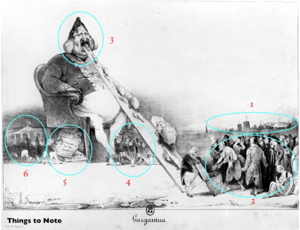 |
In the United States April 15 is the day all tax returns must be filed (April 18 in 2011 because of a public holdiay for federal workers). In honour of this important day we have gathered several illustratons and quotations which explore the idea that society is divided into two groups: that of the net tax "consumers" (or tax "eaters" as they are sometimes called) and that of the net tax "payers". These two groups have opposite interests and are therefore in conflict with each other: the tax "eaters" wanting to maintain or even increase their "food intake" and the tax payers wanting to minimize or even eradicate the amount they have to pay. This caricature from 1831 shows how Daumier thought ordinary people were exploited by the ruling elites through taxation and regulation. It was created at a time when agitation for democratic reforms were strong in both England and France and was drawn by the French republican artist Honoré Daumier for a satirical magazine in 1831. It depicts a fat and pear-shaped King Louis Philippe as a "tax eater" (the "Gargantua" from Rabelais' novel) who takes from the ordinary people and gives privileges to the ruling elite. The taxpayers (to the right) are loading baskets full of their tax money which are carried up a ramp into the king’s open mouth. Some well dressed citizens gather around his feet to collect the coins which fall to the ground. From the king’s commode (or toilet) fall official documents which grant various privileges and honours to those waiting below, before they rush off to the National Assembly in the background. For making this drawing Daumier spent 6 months in prison for offending the king. [more] Honoré Daumier, “Gargantua” (1831) [See the longer essay.] |
An anti-Gaddafi Mural in Benghazi
image |
"It never rains but it pours": The collapse of censorship in eastern Libya has unleashed an outpouring of anti-Gaddafi art in Benghazi. [See a larger version - 800px] |
Thomas Nast and the Slavery of the Income Tax (1878)
 |
Thomas Nast drew this cartoon in order to voice his opposition to the re-introduction of an income tax in 1878. It is clear that although soft money, regulations, and other taxes were a burden for "Peace" (the balls and chains which bind her hands behind her back), by far the greater burden was that of the new war-time income tax which hangs about her bowed head. Nast also suggests that heavy taxes have brought commerce and industrial production to a low level and that corrupt law-makers use the income tax to whip up antagonism between "Capital" and "Labor". Nast and the anti-income tax lobbyists were able to defeat the proposed bills in 1878 but they were not able to keep it from being re-enacted in 1894, and made permanent with the 16th Amendment of 1913. [More] |

